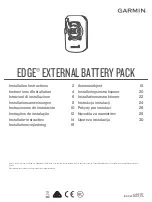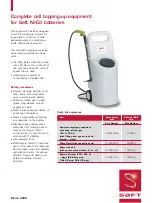
•
7
•
RATE SELECTION BUTTON
Use this button to select one of the following:
• 6<>2A CHARGE – For charging small and large batteries. Not recommended for industrial applications.
• BOOST – For quickly adding energy to a severely discharged or large capacity battery prior to Engine Start.
• ENGINE START – Provides additional amps for cranking an engine with a weak or run-down battery.
Always use in combination with a battery.
START/STOP BUTTON
Press to immediately begin charging your properly connected battery. If the button is not pressed,
charging should begin in 30 seconds.
BATTERY TYPE BUTTON
Use this button to select the battery type.
• STANDARD – Used in cars, trucks and motorcycles, these batteries have vent caps and are often marked
“low maintenance” or “maintenance-free”. This type of battery is designed to deliver quick bursts of energy
(such as starting engines) and has a greater plate count. The plates are thinner and have somewhat
different material composition. Regular batteries should not be used for deep-cycle applications.
• AGM – The Absorbed Glass Mat construction allows the electrolyte to be suspended in close proximity
with the plate’s active material. In theory, this enhances both the discharge and recharge efficiency. The
AGM batteries are a variant of Sealed VRLA (valve regulated lead-acid) batteries. Popular uses include
high-performance engine starting, power sports, deep-cycle, solar and storage batteries.
• GEL – The electrolyte in a GEL cell has a silica additive that causes it to set up or stiffen. The recharge
voltages on this type of cell are lower than those for other styles of lead-acid battery. This is probably the
most sensitive cell in terms of adverse reactions to overvoltage charging. Gel batteries are best used in
VERY DEEP cycle application and may last a bit longer in hot weather applications. If the wrong battery
charger is used on a gel cell battery, poor performance and premature failure will result.
11. OPERATING INSTRUCTIONS
WARNING: A SPARK NEAR THE BATTERY MAY CAUSE AN EXPLOSION.
CHARGING A BATTERY IN THE VEHICLE
1. Turn off all the vehicle’s accessories.
2. Keep the hood open.
3. Clean the battery terminals.
4. Place the charger on a dry, non-flammable surface.
5. Lay the AC/DC cables away from any fan blades, belts, pulleys and other moving parts.
6. Connect the battery, following the precautions listed in sections 6 and 7.
7. Connect the charger to a live, grounded 120V AC outlet.
8. Select the battery type and charge rate.
9. Press the START button to begin charging immediately. If START button is not pressed within ten
minutes after unit was first powered up, and the charger detects a battery that is properly connected,
the charging process will automatically begin and finish. Unit will automatically switch between
BOOST and CHARGE rates as needed.
10. When charging is complete, or if you are done using Engine Start or Boost modes, press STOP button,
disconnect the charger from the AC power, disconnect the clamp attached to vehicle’s chassis, and
finally remove the clamp from battery terminal.
CHARGING A BATTERY OUTSIDE OF THE VEHICLE
1. Place battery in a well-ventilated area.
2. Clean the battery terminals.
3. Connect the battery, following the precautions listed in sections 6 and 7.
4. Connect the charger to a live grounded 120V AC outlet.
5. Select the battery type and charge rate.








































